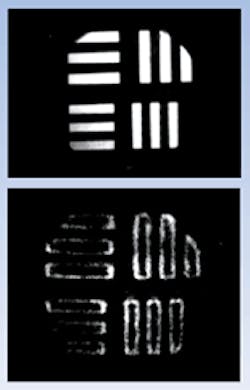
In edge enhancement, the edges of objects (or, commonly, areas of rapid intensity change) within an image are made to stand out. It is an image-processing technique commonly used to help machine-vision systems determine where and how many objects are in an image. The method normally depends on computer calculation: in one approach, the derivative of the digitized image-intensity field is calculated, and in places where the derivative is high, an edge is assumed to exist. An all-optical setup developed by researchers at the Nagaoka University of Technology (Nagaoka, Japan) and the Himeji Institute of Technology (Himeji, Japan) now allows edge enhancement to be done without digitization or software.1 The setup relies on effects that occur within a photorefractive liquid crystal.
The material, termed a polymer-dissolved liquid-crystal composite (PDLCC), contains a copolymer, a low-molar-mass liquid crystal, and a sensitizing dye. Two glass substrates with transparent electrodes and 50-mm-thick spacer films form a cell into which the photorefractive PDLCC is poured. The filled cell is part of an optical system containing a Fourier-transform lens; the cell itself is placed at the Fourier transform of the image to be analyzed. The beam from a frequency-doubled diode-pumped Nd:YAG laser emitting at 532 nm is split, with part providing a signal beam for the optical system and the other part a reference beam that is shone directly on the PDLCC cell.
In operation, the two beams interfere within the cell, producing gratings. A holographic optical image produced by the gratings is reconstructed with a 633-nm read beam. For low-frequency gratings at the center of the Fourier transform, the ratio of reference to signal-beam intensity is much less than one, producing gratings with poor diffraction efficiency. For higher frequencies near the edge of the Fourier transform, however, the intensity ratio of reference and signal beams is approximately equal, creating efficient gratings. These higher frequencies that give rise to edge enhancement are efficiently reconstructed in real time by the read beam.
Adjusting the intensity ratio of the two 532-nm beams makes the edge-enhancement effect either disappear (top) or appear (bottom). Researcher Hiroshi Ono says that an early use for this technique will be as a preliminary operation to lighten the load on traditional image-processing systems.
REFERENCE
- H. Ono et al., Appl. Phys. Lett. 79(7), 895 (Aug. 13, 2001).
About the Author
John Wallace
Senior Technical Editor (1998-2022)
John Wallace was with Laser Focus World for nearly 25 years, retiring in late June 2022. He obtained a bachelor's degree in mechanical engineering and physics at Rutgers University and a master's in optical engineering at the University of Rochester. Before becoming an editor, John worked as an engineer at RCA, Exxon, Eastman Kodak, and GCA Corporation.
